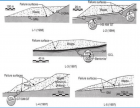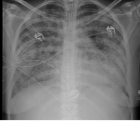Abstract
Review Article
Use of Geosynthetic materials in solid waste landfill design: A review of geosynthetic related stability issues
MA Karim* and Lin Zhao
Published: 22 June, 2018 | Volume 2 - Issue 1 | Pages: 006-015
Geosynthetics used in landfills provides a technical and economic advantages over traditional clay liners. It may create stability issue and even lead to landfill failure due to its low interface or internal shear strength if improperly designed and/or constructed. The most common failure mechanism in geosynthetic-lined landfills is transitional failure involving waste and bottom liner (deep-seated failure) or only final cover system (shallow failure). Shear strengths of geosynthetic-geosynthetic and geosynthetic-soil have a wide range of variations. Shear strengths of interface from literature may be used in preliminary design. For final design, site-specific interface shear strengths shall be used. Internal shear strengths of unreinforced geosynthetic clay liner (GCL) are less than those of reinforced GCLs. Unreinforced GCLs are not recommended for slopes steeper than 1:10 (1 Vertical and 10 Horizontal). Peak shear strength of interface and internal GCLs can be used in bottom liner; residual shear strength of interface and internal GCLs shall be used for geosynthetic placed along the slopes. Site-specific shear strengths of waste are recommended to be used in the design. Landfill failure could be triggered by static loadings including excessive leachate, pore pressure above the bottom liners, gas pressure, and excessive wetness of the geomembrane-GCL, and earthquake loading. The factor of safety of 1.5 is recommended for static loading and 1.0 for earthquake loading. A higher factor of safety is recommended if a failure could have a catastrophic effect on human health or the environment, and if large uncertainty exists in input parameters to calculate the factors of safety. The main objective of this review article is to provide a comprehensive knowledge of slope failure mechanisms, causes, and probable remedies in one place.
Read Full Article HTML DOI: 10.29328/journal.acee.1001010 Cite this Article Read Full Article PDF
Keywords:
Geosynthetics; Solid waste landfill; Slope failure; Slope stability; Shear strength; Triggering cause
References
- Bouazza A, Zornberg JG, Adam D. Geosynthetics in Waste Containment Facilities: Recent Advances. Geosynthetics. 2002; 2: 445-510. Ref.: https://tinyurl.com/y78rg6f4
- Landreth RE. Opportunity for Use of Geosynthetics in Waste Management Facilities. 2nd International High-Performance Fabrics Conference Proceedings. 1992; 153-166. Ref.: https://tinyurl.com/y7mx28rh
- Mitchell JK, Chang M, Seed RB. The Kettleman Hills Landfill Failure: A Retrospective View of the Failure Investigations. International Conference on Case Histories in Geotechnical Engineering. 1993. Ref.: https://tinyurl.com/y6vpqo6t
- Koerner RM, Soong TY. Leachate in landfills: the stability issues. Geotextile and Geomembrane. 2000; 18: 293-309. Ref.: https://tinyurl.com/yag7g2dj
- Ohio EPA. Geotechnical and Stability Analyses for Ohio Waste Containment Facilities. 2004. Ref.: https://tinyurl.com/ya3sebe3
- Robert M Koerner. Design with Geosynthetics. 6th Edition. 2012.
- Richardson GN, Zhao A. Geosynthetic Fundamentals in Landfill Design. Advances in Environmental Geotechnics. 2009. Ref.: https://tinyurl.com/y9uvxwxd
- Jones DRV, Dixon N. Stability of Landfill Lining Systems: Report No. 1 Literature Review. R&D Technical Report. 2003. Ref.: https://tinyurl.com/y7yzwzdq
- Jones DRV, Dixon N. A comparison of geomembrane/geotextile interface shear strength by direct shear and ring shear. Proceedings 2nd European Conference on Geosynthetics. 2000; 2: 929-932.
- Richardson GN, Thiel RS, Marr WA. Lessons Learned From the Failure of a GCL/Geomembrane Barrier on a Side Slope Landfill Cover. 2000.
- Stark TD, Williamson TA, Eid HT. HDPE Geomembrane/Geotextiles Interface Shear Strength. J Geotechnical Engineering. 1996; 122. Ref.: https://tinyurl.com/y8pjw9sq
- Gilbert RB. Peak versus residual strength for waste containment systems. Proceedings 15th GRI Conference. 2001; 29-39.
- Thiel Engineering. Engineering Report: Appendix C Volume 2 - Alternative Bottom Liner System, Cowlitz County Headquarters Landfill Project, Cowlitz County, Washington. 2009.
- Richardson GN. GCL internal shear strength requirements. Geosynthetics Fabric Report. 1997; 15: 20-25. Ref.: https://tinyurl.com/y7uzd7bt
- McCartney JS, Zornberg JG, Swan R. Internal and Interface Shear Strength of Geosynthetic Clay Liners (GCLs). Geotechnical Research Report. 2002; 386. Ref.: https://tinyurl.com/y9qaeu2o
- Van Impe WF, Bouazza A. Geotechnical Properties of MSW. 2nd Int. Congress on Environmental Geotechnics. The Netherlands.
Figures:

Figure 1

Figure 2

Figure 3

Figure 4

Figure 5

Figure 6

Figure 7

Figure 8

Figure 9
Similar Articles
-
Use of Geosynthetic materials in solid waste landfill design: A review of geosynthetic related stability issuesMA Karim*,Lin Zhao. Use of Geosynthetic materials in solid waste landfill design: A review of geosynthetic related stability issues. . 2018 doi: 10.29328/journal.acee.1001010; 2: 006-015
Recently Viewed
-
Prediction of neonatal and maternal index based on development and population indicators: a global ecological studySedigheh Abdollahpour,Hamid Heidarian Miri,Talat Khadivzadeh*. Prediction of neonatal and maternal index based on development and population indicators: a global ecological study. Clin J Obstet Gynecol. 2021: doi: 10.29328/journal.cjog.1001096; 4: 101-105
-
A Genetic study in assisted reproduction and the risk of congenital anomaliesKaparelioti Chrysoula,Koniari Eleni*,Efthymiou Vasiliki,Loutradis Dimitrios,Chrousos George,Fryssira Eleni. A Genetic study in assisted reproduction and the risk of congenital anomalies. Clin J Obstet Gynecol. 2021: doi: 10.29328/journal.cjog.1001095; 4: 096-100
-
Leiomyosarcoma in pregnancy: Incidental finding during routine caesarean sectionToon Wen Tang*,Phoon Wai Leng Jessie. Leiomyosarcoma in pregnancy: Incidental finding during routine caesarean section. Clin J Obstet Gynecol. 2021: doi: 10.29328/journal.cjog.1001094; 4: 092-095
-
Adult Neurogenesis: A Review of Current Perspectives and Implications for Neuroscience ResearchAlex, Gideon S*,Olanrewaju Oluwaseun Oke,Joy Wilberforce Ekokojde,Tolulope Judah Gbayisomore,Martina C. Anene-Ogbe,Farounbi Glory,Joshua Ayodele Yusuf. Adult Neurogenesis: A Review of Current Perspectives and Implications for Neuroscience Research. J Neurosci Neurol Disord. 2024: doi: 10.29328/journal.jnnd.1001102; 8: 106-114
-
Late discover of a traumatic cardiac injury: Case reportBenlafqih C,Bouhdadi H*,Bakkali A,Rhissassi J,Sayah R,Laaroussi M. Late discover of a traumatic cardiac injury: Case report. J Cardiol Cardiovasc Med. 2019: doi: 10.29328/journal.jccm.1001048; 4: 100-102
Most Viewed
-
Evaluation of Biostimulants Based on Recovered Protein Hydrolysates from Animal By-products as Plant Growth EnhancersH Pérez-Aguilar*, M Lacruz-Asaro, F Arán-Ais. Evaluation of Biostimulants Based on Recovered Protein Hydrolysates from Animal By-products as Plant Growth Enhancers. J Plant Sci Phytopathol. 2023 doi: 10.29328/journal.jpsp.1001104; 7: 042-047
-
Sinonasal Myxoma Extending into the Orbit in a 4-Year Old: A Case PresentationJulian A Purrinos*, Ramzi Younis. Sinonasal Myxoma Extending into the Orbit in a 4-Year Old: A Case Presentation. Arch Case Rep. 2024 doi: 10.29328/journal.acr.1001099; 8: 075-077
-
Feasibility study of magnetic sensing for detecting single-neuron action potentialsDenis Tonini,Kai Wu,Renata Saha,Jian-Ping Wang*. Feasibility study of magnetic sensing for detecting single-neuron action potentials. Ann Biomed Sci Eng. 2022 doi: 10.29328/journal.abse.1001018; 6: 019-029
-
Pediatric Dysgerminoma: Unveiling a Rare Ovarian TumorFaten Limaiem*, Khalil Saffar, Ahmed Halouani. Pediatric Dysgerminoma: Unveiling a Rare Ovarian Tumor. Arch Case Rep. 2024 doi: 10.29328/journal.acr.1001087; 8: 010-013
-
Physical activity can change the physiological and psychological circumstances during COVID-19 pandemic: A narrative reviewKhashayar Maroufi*. Physical activity can change the physiological and psychological circumstances during COVID-19 pandemic: A narrative review. J Sports Med Ther. 2021 doi: 10.29328/journal.jsmt.1001051; 6: 001-007

HSPI: We're glad you're here. Please click "create a new Query" if you are a new visitor to our website and need further information from us.
If you are already a member of our network and need to keep track of any developments regarding a question you have already submitted, click "take me to my Query."
















































































































































